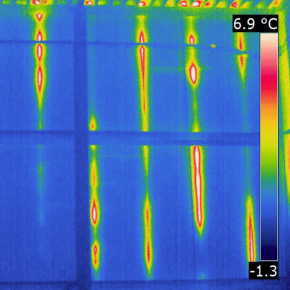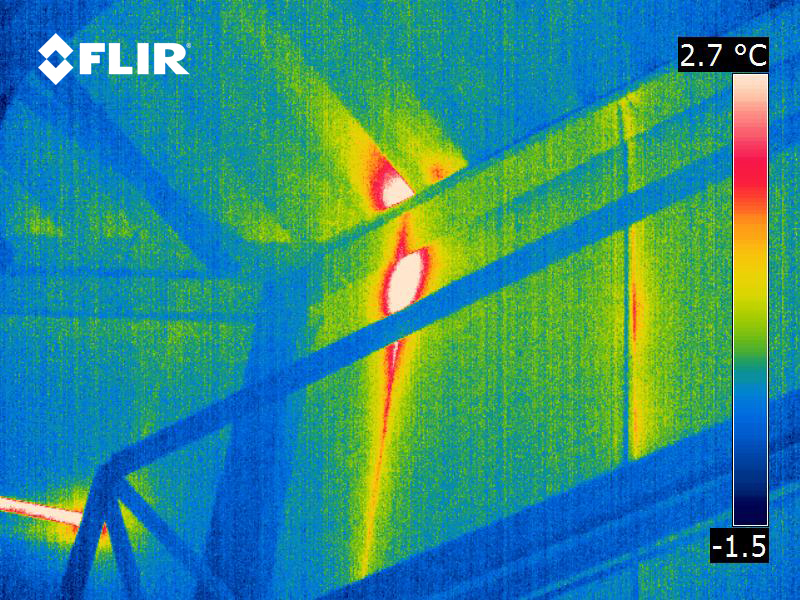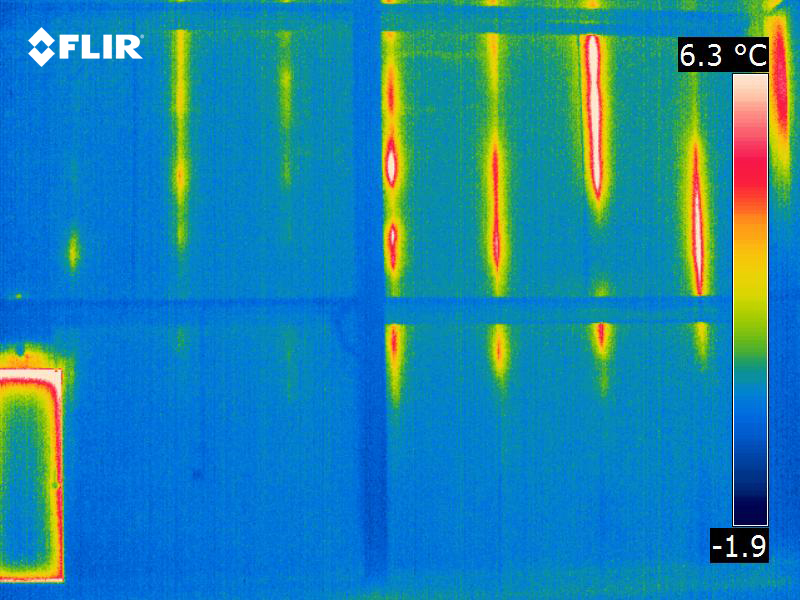
Freezer insulation inspection – FLIR thermal imaging keeps costs down
As important as they are for storing quantities of foodstuffs, commercial walk-in freezers use a lot of energy. So, it is imperative that this consumption is kept to a minimum, which FLIR can help with.
This can be done by ensuring the temperature inside the freezer is not compromised by any breach in the freezer’s insulation.
Thermal imaging is proving the ideal technology for this purpose and the process is much the same as seeking out faults in building fabric.

The only difference is the direction of heat – when inspecting a building, a thermographer will generally look for heat leaking from the inside of the structure to the outside. But with refrigeration units, the main requirement is to detect heat leaking inwards.
In many cases, the problem lies with faulty construction, so even the operating costs of new freezers can be unnecessarily high.
Frequently, joints between the insulation panels are not protected adequately, creating heat bridges. In older units insulation faults are common due to wear but in both cases thermal imaging can see the problem in an instant. However, the quality of the infrared camera is key to the success of this application.

The Dutch consultancy, Thermografisch en Adviesbureau, is frequently commissioned to conduct thermal inspection of commercial freezers.
Its spokesman explained: “Thermal sensitivity, accuracy and resolution are crucial to the accurate detection of thermal bridges.
“You need to be able to interpret what you see in a thermal image and if you are using a thermal imaging camera that is below 640 x 480 pixels then you are missing information that you need to draw the right conclusions.”

The most sophisticated FLIR thermal imaging camera the consultancy uses for its work combines high resolution with 30mK thermal sensitivity and an accuracy of ±2°C; another important feature for freezer inspection the company cites is calibration range.
The spokesman added: “Our FLIR camera is calibrated to a minimum temperature of -40°C and this is very important to ensure accuracy temperature measurement.
“Most freezers are kept at a temperature between -20°C and -30°C. However, some freezers cool their contents down to -50°C or even -60°C and the FLIR camera is still capable of visualising insulation leaks.
“High quality thermal imaging cameras and good training come at a price but they are definitely worth the money.
“We have several FLIR cameras that are used for a wide variety of applications from building, industrial maintenance and HVAC system inspection to detecting water ingress in aircraft composite materials. Our cameras are constantly on the move from site to site.”
FLIR Systems,
2 Kings Hill Avenue,
Kings Hill,
West Malling,
Kent,
United Kingdom
ME19 4AQ
Phone: 01732 220011
Fax: 01732 220014
Visit Supplier's page
Latest news

28th March 2025
Ideal Heating Commercial announces 10-year warranty on Evomax 2 boiler
Evomax 2, the UK’s number one selling commercial wall-mounted boiler from Ideal Heating Commercial, is now available with a 10-year warranty.
Posted in Articles, Building Industry News, Building Products & Structures, Building Regulations & Accreditations, Building Services, Facility Management & Building Services, Heating Systems, Controls and Management, Heating, Ventilation and Air Conditioning - HVAC, Innovations & New Products, Pipes, Pipes & Fittings, Plumbing, Retrofit & Renovation, Sustainability & Energy Efficiency, Videos
28th March 2025
FLIR Si1-LD Acoustic Imaging Camera for Compressed Air Leak Detection
FLIR, a Teledyne Technologies company, introduces the Si1-LD, an industrial acoustic imaging camera that brings faster and more accurate compressed air leak detection to those operating on a modest condition monitoring budget.
Posted in Acoustics, Noise & Vibration Control, Articles, Building Industry News, Building Products & Structures, Building Services, Facility Management & Building Services, Information Technology, Innovations & New Products, Retrofit & Renovation, Sustainability & Energy Efficiency, Thermal Imaging and Monitors
28th March 2025
LIFTEX 2025 Seminar programme announced
Registration has opened for LIFTEX 2025. Now in its 37th year, LIFTEX 2025 is the UK’s only dedicated exhibition for the lift, escalator and access industry and takes place only once every three years.
Posted in Access Control & Door Entry Systems, Accessibility, Articles, Building Industry Events, Building Industry News, Building Products & Structures, Building Regulations & Accreditations, Building Services, Exhibitions and Conferences, Facility Management & Building Services, Health & Safety, Retrofit & Renovation, Security and Fire Protection, Seminars
28th March 2025
MCRMA welcomes ArcelorMittal UK to membership
A UK division of the global steelmaking business ArcelorMittal has become the latest new member of the MCRMA, the industry association representing the metal building envelope sector.
Posted in Articles, Building Associations & Institutes, Building Industry News, Building Products & Structures, Building Systems, Cladding, Facades, Posts, Restoration & Refurbishment, Retrofit & Renovation, Roofs, Steel and Structural Frames, Walls
 Sign up:
Sign up: